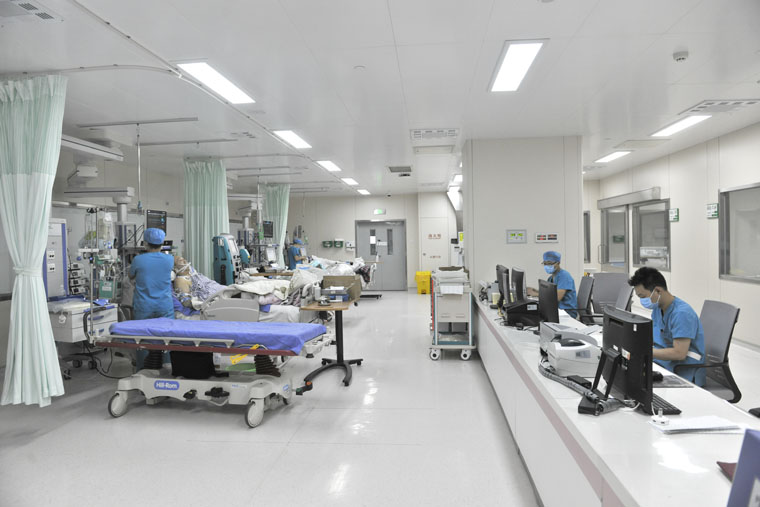
The Department of Intensive Care Unit was founded in 1991. In October 1992, with the assistance of the government of Japan and the Affiliated Hospital of Fukushima Medical University, an "ICU of China Japan Friendship The Fourth Hospital of Hebei Medical University" was established. In October 2009, the Department of critical medicine of Dongyuan District of our hospital was established with the same function as our department. At present, the Department has 4 professors and chief physicians, 4 associate professors and deputy chief physicians, 9 attending physicians and 4 residents. In 2010, the Department of critical medicine was awarded the first batch of "national key clinical specialty" in China, and in 2017, it was again awarded the "key discipline of Hebei Province". Many doctors in the Department are core members and lecturers of the "China severe ultrasound research group". At present, they can skillfully carry out bedside severe ultrasound technology. Since its establishment, it has made great progress in medicine, teaching and research. Both clinical ability and academic level are at the first-class level in China, leading the province.
At present, there are 52 beds in the Department of Intensive Care Unit of our hospital (43 in this department (20 are open now), and 9 in the east hospital area). Each monitoring bed shall be equipped with complete functional equipment belt or functional rack, providing power supply, oxygen, compressed air, negative pressure suction and other functional support. Each bed is equipped with a bedside monitoring system to monitor ECG, blood pressure, pulse oxygen saturation, invasive blood pressure and other basic vital signs. Each bed is equipped with 1 ventilator, and equipped with infusion pump and micro injection pump. The departments include extracorporeal membrane oxygenation (ECMO), continuous renal replacement therapy (CRRT), intra aortic balloon pump (IABP), pulse index continuous cardiac output measurement (pulse index continuous cardiac output) Output, PiCCO), bedside ultrasound, fiberbronchoscope, electrocardiograph, defibrillator, blood gas analyzer, cardiopulmonary resuscitation rescue equipment vehicle (equipped with laryngoscope, tracheal tube, various joints, first-aid drugs and other rescue tools), electronic temperature rise and fall equipment, etc.
The scope of treatment in the Department of critical medicine: 1. Acute, reversible, life-threatening organ dysfunction, patients who may recover in a short time after intensive care and intensive treatment in ICU. 2. There are various high-risk factors with potential life risks. Patients who may reduce the risk of death through intensive ICU monitoring and effective treatment at any time. 3. On the basis of chronic organ dysfunction, patients with acute aggravation and life-threatening may return to their original state after intensive care and treatment in ICU. 4. The end state of chronic consumptive diseases, irreversible diseases and patients who can not benefit from ICU monitoring and treatment are generally not the scope of ICU treatment.
At present, the Department of Intensive Care Unit of our hospital has mastered the theory and skills of monitoring and supporting the important organ and system functions of severe patients, including: (1) treatment of multiple organ failure; (2) diagnosis and treatment of various types of shock, especially the treatment of infectious shock; (3) treatment of respiratory failure and severe acute respiratory distress syndrome caused by various causes; (4) acute renal injury and Continuous blood purification technology; (5) severe ultrasound technology; (6) treatment of central nervous system dysfunction; (7) treatment of severe liver dysfunction; (8) gastrointestinal dysfunction and gastrointestinal hemorrhage; (9) acute coagulation dysfunction; (10) serious endocrine and metabolic disorders; (11) water electrolyte and acid-base balance disorders; (12) enteral and parenteral nutrition support; (13) Sedation and analgesia; (14) severe infection; (15) immune dysfunction. The Department has the ability to independently complete the following monitoring and support technologies: (1) advanced hemodynamic support technologies such as ECMO and IABP; (2) establishment and management of artificial airway; (3) ARDS protective mechanical ventilation and prone position technology; (4) fiberbronchoscopy technology; (5) deep vein and artery puncture catheterization technology; (6) hemodynamic monitoring technology; (7) severe ultrasound technology (8) cardioversion and defibrillation; (9) continuous blood purification.